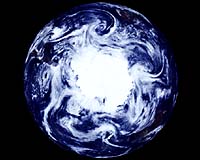| . |  |
. |
Cambridge UK (SPX) Jun 03, 2010 Scientists have found the possible source of a huge carbon dioxide 'burp' that happened some 18,000 years ago and which helped to end the last ice age. The results provide the first concrete evidence that carbon dioxide (CO2) was more efficiently locked away in the deep ocean during the last ice age, turning the deep sea into a more 'stagnant' carbon repository - something scientists have long suspected but lacked data to support. Working on a marine sediment core recovered from the Southern Ocean floor between Antarctica and South Africa, the international team led by Dr Luke Skinner of the University of Cambridge radiocarbon dated shells left behind by tiny marine creatures called foraminifera (forams for short). By measuring how much carbon-14 (14C) was in the bottom-dwelling forams' shells, and comparing this with the amount of 14C in the atmosphere at the time, they were able to work out how long the CO2 had been locked in the ocean. By linking their marine core to the Antarctic ice-cores using the temperature signal recorded in both archives, the team were also able compare their results directly with the ice-core record of past atmospheric CO2 variability. According to Dr Skinner: "Our results show that during the last ice age, around 20,000 years ago, carbon dioxide dissolved in the deep water circulating around Antarctica was locked away for much longer than today. If enough of the deep ocean behaved in the same way, this could help to explain how ocean mixing processes lock up more carbon dioxide during glacial periods." Throughout the past two million years (the Quaternary), the Earth has alternated between ice ages and warmer interglacials. These changes are mainly driven by alterations in the Earth's orbit around the sun (the Milankovic theory). But changes in Earth's orbit could only have acted as the 'pace-maker of the ice ages' with help from large, positive feedbacks that turned this solar 'nudge' into a significant global energy imbalance. Changes in atmospheric CO2 were one of the most important of these positive feedbacks, but what drove these changes in CO2 has remained uncertain. Because the ocean is a large, dynamic reservoir of carbon, it has long been suspected that changes in ocean circulation must have played a major role in motivating these large changes in CO2. In addition, the Southern Ocean around Antarctica is expected to have been an important centre of action, because this is where deep water can be lifted up to the sea surface and 'exhale' its CO2 to the atmosphere. Scientists think more CO2 was locked up in the deep ocean during ice ages, and that pulses or 'burps' of CO2 from the deep Southern Ocean helped trigger a global thaw every 100,000 years or so. The size of these pulses was roughly equivalent to the change in CO2 experienced since the start of the industrial revolution. If this theory is correct, we would expect to see large transfers of carbon from the ocean to the atmosphere at the end of each ice age. This should be most obvious in the relative concentrations of radiocarbon (14C) in the ocean and atmosphere; 14C decays over time and so the longer carbon is locked up in the deep sea, the less 14C it contains. As well as providing evidence for rapid release of carbon dioxide during deglaciation, the research illustrates how the ocean circulation can change significantly over a relatively short space of time. "Our findings underline the fact that the ocean is a large and dynamic carbon pool. This has implications for proposals to pump carbon dioxide into the deep sea as a way of tackling climate change, for example. Such carbon dioxide would eventually come back up to the surface, and the question of how long it would take would depend on the state of the ocean circulation, as illustrated by the last deglaciation," says Dr Skinner.
Share This Article With Planet Earth
Related Links University of Cambridge Beyond the Ice Age
 Ocean's carbon 'burp' helped end last ice age: study
Ocean's carbon 'burp' helped end last ice age: studyWashington (AFP) May 27, 2010 A giant "burp" of carbon dioxide stored under the ocean between South Africa and Antarctica may have helped end the last ice age more than 18,000 years ago, according to a new study. The study, led by a scientist from Cambridge University, is "the first concrete evidence that carbon dioxide was more efficiently locked away in the deep ocean during the last ice age." The team made its dis ... read more |
|
| The content herein, unless otherwise known to be public domain, are Copyright 1995-2010 - SpaceDaily. AFP and UPI Wire Stories are copyright Agence France-Presse and United Press International. ESA Portal Reports are copyright European Space Agency. All NASA sourced material is public domain. Additional copyrights may apply in whole or part to other bona fide parties. Advertising does not imply endorsement,agreement or approval of any opinions, statements or information provided by SpaceDaily on any Web page published or hosted by SpaceDaily. Privacy Statement |